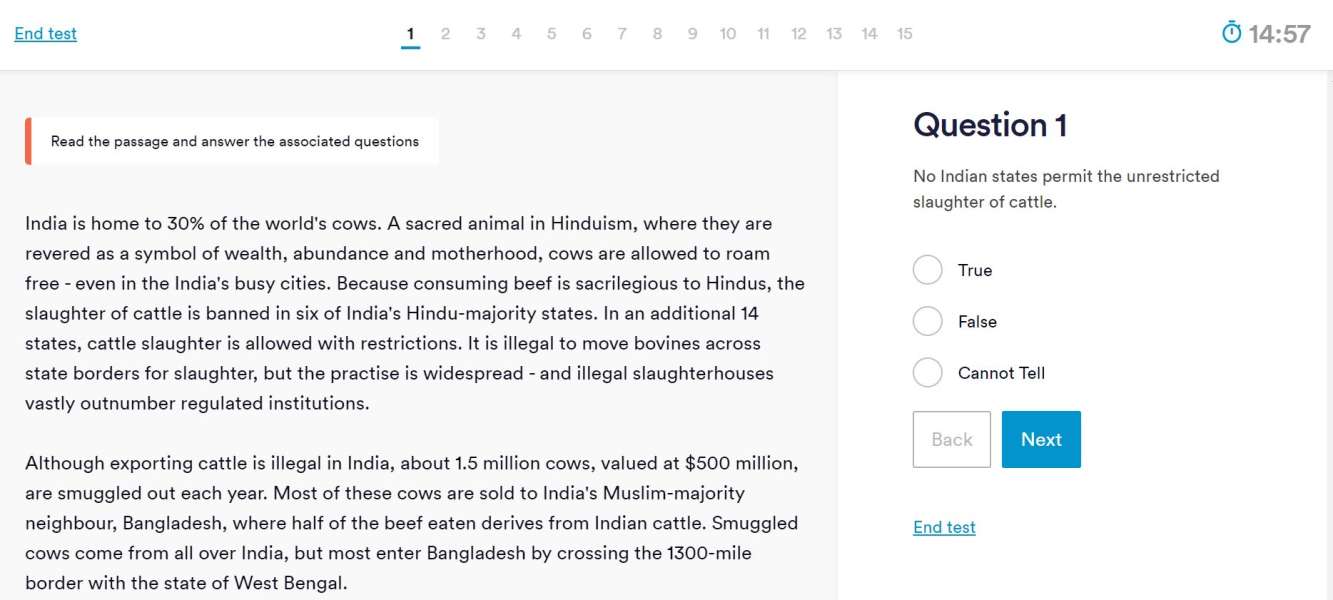Verbal Reasoning Test Questions and Answers
Free Verbal Reasoning Test Questions and Answers
Welcome to our free verbal reasoning test practice questions.
Here are a few verbal reasoning test questions to practice to give you an understanding of what real verbal reasoning tests assessment will be like. The only way to tackle these types of tests and become good at them is to practice, so make the most of these free questions and use our explanations to help you improve your performance.

Passage
India is home to 30% of the world’s cows. A sacred animal in Hinduism, where they are revered as a symbol of wealth, abundance and motherhood, cows are allowed to roam free - even in the India’s busy cities. Because consuming beef is sacrilegious to Hindus, the slaughter of cattle is banned in six of India’s Hindu-majority states. In an additional 14 states, cattle slaughter is allowed with restrictions. It is illegal to move bovines across state borders for slaughter, but the practise is widespread - and illegal slaughterhouses vastly outnumber regulated institutions.
Although exporting cattle is illegal in India, about 1.5 million cows, valued at $500 million, are smuggled out each year. Most of these cows are sold to India’s Muslim-majority neighbour, Bangladesh, where half of the beef eaten derives from Indian cattle. Smuggled cows come from all over India, but most enter Bangladesh by crossing the 1300-mile border with the state of West Bengal.
Efforts to control smuggling have included issuing cows with photo identification, but these measures have proven ineffective. While much of India’s border with Bangladesh is fenced with barbed wire and heavily policed, bribery of guards is rife. Each year approximately 100 deaths result from violent clashes between smugglers and border guards. Many object to this excessive use of force and believe cattle trade between the two nations should be legalized. However, mutual distrust and a fear of igniting religious tension make this unlikely.
Q1) No Indian states permit the unrestricted slaughter of cattle.
A) True B) False C) Cannot Tell
Answer
Cannot say – the passage does not specify how many Indian states there are or whether any allow unrestricted cattle slaughter. While it does mention that six Hindu-majority states have outright bans and 14 states permit slaughter with restrictions, it does not clarify the rules in the remaining states. (In fact, 4 do permit unrestricted slaughter) Without this information, we cannot definitively conclude whether unrestricted cattle slaughter is allowed anywhere in India.
Q2) Hindus do not eat beef because the religion considers cows to be deities.
A) True B) False C) Cannot Tell
Answer
False – the first paragraph states that cows are “sacred” and “revered”, but this does not mean that they are deities.
Q3) There is a disparity between Indian laws restricting cattle trade and reality.
A) True B) False C) Cannot Tell
Answer
True – this summarizes the entire passage, which explains that despite cows’ sacred status in India, illegal trade and slaughter of the animals is rife.
Q4) India has a 1300-mile border with Bangladesh, over which most cattle smuggling occurs.
A) True B) False C) Cannot Tell
Answer
Cannot tell – the second paragraph states that the border between West Bengal and Bangladesh is 1300 miles long. While it is true that this is where most cattle smuggling occurs, it is not possible from the information provided to say whether India’s border with Bangladesh is 1300 miles long.
Q5) Cattle smugglers are not the only individuals to profit from this lucrative, but illegal, enterprise
A) True B) False C) Cannot Tell
Answer
True – the third paragraph states that border police receive bribes from cattle smugglers.
Further Reading:
If you want more information about verbal reasoning assessments and how to prepare for them check out the resources below: